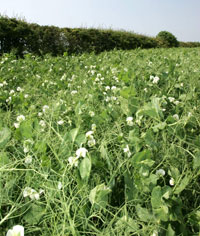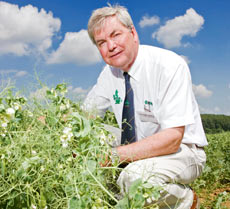PGRO open day: Plenty of progress with pulses

Developments in pest and weed control plus new pea and bean varieties were on display at last week’s PGRO/BEPA open day
Novel varieties in pipeline show promise
Pea and bean variety choice across winter and spring crops is dominated by three varieties – Prophet, Fuego and Wizard – but alternatives were coming through the testing system, the PGRO’s Steve Belcher told visitors.
Prophet, the large blue pea added to the Recommended List in 2007, was the most popular combining pea, but Crackerjack and Bluemoon would receive full recommendation in 2010, he said.
 |
|---|
There are plenty of useful pulse varieties coming through trials, says Steve Belcher |
“There are also four pea varieties in their first year of trials, three large blues and one maple variety.”
Fuego was the top selling spring bean, he noted. “But there are two varieties which will be fully recommended for 2010: Memphis and Betty. The latter has better downy mildew resistance than Fuego, but it’s lower yielding.”
Tattoo, a low-tannin variety, was another year behind. “It’s a white flowered bean, which is of interest to home users.”
In winter beans, Wizard accounted for 90% of the UK crop area. “There are five varieties in trials, with no new ones joining the list later this year.”
Sultan was provisionally recommended and higher yielding than Wizard, but had smaller seeds. “It’s also slightly shorter and earlier to mature, so it has some good agronomic advantages. But the seed size may affect its marketability.”
Among vining peas, two petit-pois varieties were showing promise, said PGRO’s Shona Johnson.
“Noroit is three days earlier than the standard Waverex as well as being shorter. CMG 4098F is a semi-leafless variety, one day later than Waverex, but higher yielding and with very good standing ability.”
Otherwise, there were five vining peas due to complete trials this year. “The early type, Salinero, has similar yields and maturity to Avola, but the produce is smaller.”
Medium maturity varieties include Recital, Biktop, Boogie and Yoda. Of these, Biktop, with a very high yield, stood out.
Seed treatment looks good
Syngenta’s insecticide seed treatment thiamethoxam showed great promise in controlling pea seedling pests, said the PGRO’s Anthony Biddle.
“It’s the only such product for peas.”
 |
|---|
Anthony Biddle hopes TMX seed treatment will be approved in time for use on next season’s pea crops |
A dramatic reduction in thrips damage had been recorded in PGRO trials, reported Dr Biddle.
“Thrips are an issue on stony, cold soils, where they reduce early emergence and cause dwarfing syndrome. The usual control is to apply Hallmark once you can see the rows.”
Pea and bean weevil caused direct feeding damage when they arrived in crops, and their larvae damaged developing root nodules, he noted.
“Damage from the pest has been significantly reduced across all varieties where thiamethoxam has been used. It could replace the current need for two pyrethroid sprays 7-10days apart.”
The chemical offered bean seed fly control in late planted vining peas. “In the right conditions, you can lose a whole field to this pest.”
It also had an effect on pea aphids. “They’re involved in virus transmission. The seed treatment won’t control them all through the season, but it does help to limit populations early on.”
In peas, thiamethoxam would have to be co-applied with seed treatment Wakil (cymoxanil + fludioxinil +metalaxyl-M), noted Dr Biddle. “Hopefully, registration will be through for the 2010 season.”
Volunteer spud control products merit care
Flumioxazin products could be used to control volunteer potatoes in vining peas, after off-label approval earlier this year, noted technical officer Jim Scrimshaw.
“Flumioxazin suppresses volunteer potatoes, helping prevent flower and berry formation,” he said.
 |
|---|
Basagran is the only post-emergence herbicide option in winter beans, says Jim Scrimshaw |
Most varieties coped well with the herbicide, although good wax levels on the crop were important, he warned. “It should be applied from 4-5 nodes up to flowers visible, to a maximum does of 100ml/ha. There’s a harvest interval of 42 days.”
Increased crop damage occurred if applications were made when the foliage was wet. “Don’t use it with an adjuvant, or in a tank-mix. And make sure you have a copy of the relevant SOLA notice before application.”
Other PGRO work had examined reduced doses of Basagran (bentazone) with adjuvants to trim weed control costs.
“Basagran is now the only post-emergence herbicide option in winter beans, but it’s expensive.”
The PGRO work showed there was scope for rate cuts. “We’ve looked at adding Toil and another adjuvant IA390, to see what can be achieved.”
Half rates of Basagran had worked well when an adjuvant was included. “We’ve seen good weed control at these levels, without causing crop damage.”

